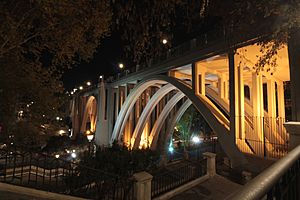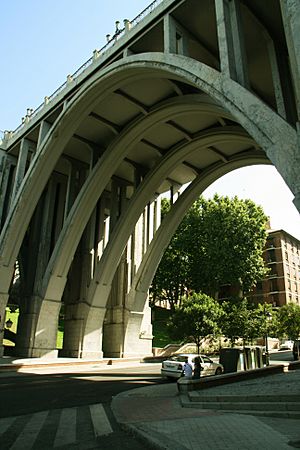Segovia Viaduct facts for kids
Quick facts for kids Segovia ViaductViaducto de Segovia |
|
|---|---|

East side of Segovia Viaduct
|
|
| Coordinates | 40°24′50″N 3°42′49″W / 40.41382°N 3.71366°W |
| Carries | Motor vehicles and pedestrians. |
| Crosses | Calle de Segovia (street) |
| Locale | Madrid, Spain. |
| Characteristics | |
| Design | Arch bridge |
| Material | Reinforced concrete |
| Height | 23 m (75 ft) |
| Longest span | 35 m (115 ft) |
| Number of spans | Three |
| History | |
| Architect | Francisco Javier Ferrero |
| Engineering design by | José Juan Aracil Luis Aldaz Muguiro |
| Construction begin | 1934 |
| Construction end | 1942 |
| Rebuilt | 1977–1978 |
The Segovia Viaduct is a large bridge in the La Latina neighborhood of Madrid, Spain. For many centuries, this area has been an important meeting point. The main job of the viaduct is to help people and vehicles travel easily between the city and the Royal Palace of Madrid. The current viaduct was built in 1934. It replaced an older iron bridge from 1874. The viaduct you see today has been fixed up many times. This was done to handle more and more traffic. It crosses over Segovia Street, which is 25 meters below it. That's how it got its name! People in Madrid often just call it "El Viaducto."
Contents
The Story of the Segovia Viaduct
Segovia Street is located in a low area that was partly formed by an old stream called San Pedro Creek. A long time ago, in the Middle Ages, this valley was a key way to enter Madrid. It connected the town to the old road that led to Segovia. This road started on the other side of the Manzanares River. The Bridge of Segovia, built between 1582 and 1584, helped people cross the Manzanares River. It was designed by the architect Juan de Herrera. This bridge replaced an even older one from the 1300s, built by Alfonso XI of Castile.
The area around the San Pedro basin had lots of fresh water and many fruit orchards. It was called El Pozacho, possibly named after a waterwheel. A drawing of Madrid from 1562 by Anton van den Wyngaerde clearly shows how steep this valley was.
Bailén Street used to stop suddenly at the edge of this valley. People had to go down and then climb back up to reach the Royal Alcázar of Madrid. Getting to and from what is now Segovia Street involved many winding paths on the slopes.
When King Philip II made Madrid the capital in 1561, he wanted to expand the city. This plan included extending Bailén Street. The idea was to build a bridge across this valley. This would connect the Royal Palace area with Vistillas to the south and beyond.
Only a small part of this big plan for Bailén Street happened before the Bourbons royal family came to power. Some buildings, including Madrid's original cathedral, were torn down. This helped to level the ground and create a new entrance to the city. This street was called Calle Real Nueva, which later became modern Segovia Street. After two failed attempts, the viaduct was finally finished in 1874. It has been completely rebuilt two times since then.
Building the First Viaduct
The very first idea for a viaduct came in 1736 from Juan Bautista Sacchetti, an Italian architect. He was working on the Royal Palace. But this project never got built. The idea for a city viaduct came up again during the time of Joseph Bonaparte (1808-1813). This time, royal architect Silvestre Perez suggested it. Again, the project didn't happen because there wasn't enough money.
Even though Silvestre Perez's city plans weren't fully carried out, the road that would become Bailén Street was completely changed. This meant buying and tearing down several homes and churches. One of these was Santa Maria de la Almudena, thought to be Madrid's oldest church, which was demolished in 1868. Construction of the new Almudena Cathedral began in 1879, right next to the Royal Palace on Bailén Street. Demolitions continued until 1883.
On January 31, 1872, the first piece of iron for the bridge was put in place. The first viaduct was built in 1874 by city engineer Eugene Barron Avignon. It was part of a larger project for Bailén Street. This project aimed to create a wide avenue running almost north-south, connecting two important places: the Royal Palace and the San Francisco el Grande Basilica. This greatly improved the nearby area, which was a bit cut off. This area was traditionally called morería vieja, or the old Moorish quarter.
The first iron bridge was considered a big achievement in engineering at the time. It crossed Segovia Street at a height of 23 meters. It was 120 meters long and 13 meters wide. It could hold a lot of weight. It opened on October 13, 1874.
Building the Second Viaduct
By 1931, the old viaduct was in poor condition. The government of the Second Republic held a competition to design a new one. The first contest was canceled, but a new one was held the next year. The winning design came from architect Francisco Javier Ferrero Lluisa. The old wooden and iron viaduct was finally torn down in 1932. This happened after many repairs and strengthening efforts in the 1920s, as cracks were first seen in 1925. The new viaduct was finished in 1934. The winning design used smooth concrete with granite bases for the pillars.
The viaduct was badly damaged by artillery during the Spanish Civil War. This was because it was very close to the fighting. It was repaired to its original design and reopened on March 28, 1942. Traffic became very heavy on Bailén Street in the 1950s and 1960s. The viaduct was designed for trams with certain weight limits, which was fine in the 1920s. But by the early 1970s, the traffic and weight on the bridge were much more than it was built for.
Building the Third Viaduct
In 1974, a study showed the viaduct was getting old and worn out. Madrid City Hall suggested fixing it. That same year, its weight limit was lowered by stopping some traffic. In 1976, all traffic on the viaduct was stopped. Bailén Street traffic was completely messed up for a few years in the 1970s. People thought about tearing it down and building a new, more modern one. But in the end, they decided to repair and keep it. This work happened between 1977 and 1978. This rebuilding kept the look of the second viaduct. It also made it two meters taller, almost 200 meters longer, and able to handle much more traffic.
What the Segovia Viaduct Looks Like
The Segovia Viaduct is built for heavy two-way car traffic. It also has sidewalks on both sides for people to walk on. At its highest point, it is 25 meters above the street below. This is a civil engineering project with a modern, simple design style. It is made of smooth concrete. The bottom parts of its pillars are covered with granite blocks. When you cross the viaduct, you can see great views of Casa de Campo, especially its lake.
See also
 In Spanish: Viaducto de Segovia para niños
In Spanish: Viaducto de Segovia para niños
- Architecture of Madrid




